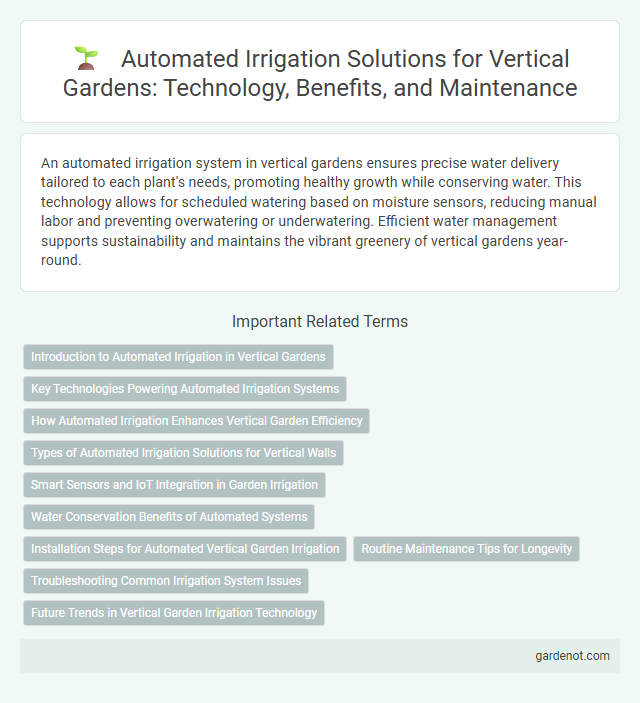An automated irrigation system in vertical gardens ensures precise water delivery tailored to each plant's needs, promoting healthy growth while conserving water. This technology allows for scheduled watering based on moisture sensors, reducing manual labor and preventing overwatering or underwatering. Efficient water management supports sustainability and maintains the vibrant greenery of vertical gardens year-round.
Introduction to Automated Irrigation in Vertical Gardens
Automated irrigation systems in vertical gardens utilize sensors and timers to regulate water delivery, ensuring precise moisture levels for optimal plant growth. These systems reduce water waste by targeting irrigation directly to plant roots, adapting to environmental conditions in real-time. Integration with smart technology enhances efficiency, promoting sustainable maintenance of vertical garden ecosystems.
Key Technologies Powering Automated Irrigation Systems
Automated irrigation systems in vertical gardens leverage key technologies such as soil moisture sensors, drip irrigation emitters, and programmable timers to optimize water usage. Advanced controllers equipped with IoT connectivity enable real-time monitoring and remote adjustments, ensuring precise hydration tailored to plant species and environmental conditions. Integration of AI algorithms enhances water efficiency by predicting plant water needs based on weather data and growth patterns.
How Automated Irrigation Enhances Vertical Garden Efficiency
Automated irrigation systems optimize water delivery in vertical gardens by precisely monitoring moisture levels and adjusting watering schedules to meet plant needs. This technology reduces water waste and promotes healthier plant growth through consistent hydration. By integrating sensors and smart controllers, automated irrigation enhances overall garden efficiency and maintenance.
Types of Automated Irrigation Solutions for Vertical Walls
Automated irrigation systems for vertical gardens include drip irrigation, micro-sprinklers, and capillary mats, each tailored to optimize water distribution across vertical surfaces. Drip irrigation delivers precise water directly to plant roots, minimizing waste and ensuring efficiency for dense plant arrangements. Micro-sprinklers offer adjustable coverage ideal for varied plant species, while capillary mats provide a consistent moisture source through passive water absorption, supporting healthy vertical wall ecosystems.
Smart Sensors and IoT Integration in Garden Irrigation
Smart sensors in automated irrigation systems optimize water usage in vertical gardens by continuously monitoring soil moisture, temperature, and light levels. IoT integration enables real-time data collection and remote control through mobile devices, enhancing precision watering schedules. This technology reduces water waste, promotes healthy plant growth, and ensures efficient resource management in urban gardening environments.
Water Conservation Benefits of Automated Systems
Automated irrigation systems in vertical gardens precisely control water delivery, significantly reducing water wastage compared to manual watering methods. These systems use sensors to monitor soil moisture and weather conditions, ensuring plants receive optimal hydration while preventing overwatering. By conserving water through efficient scheduling and targeted irrigation, automated systems support sustainable gardening practices and lower overall water consumption.
Installation Steps for Automated Vertical Garden Irrigation
Installing an automated irrigation system for a vertical garden involves mounting water-efficient drip emitters aligned with plant spacing to ensure precise hydration. Integrating a timer controller with moisture sensors optimizes water delivery by adjusting irrigation schedules based on soil moisture levels, reducing water waste. Properly connecting the irrigation tubing to a reliable water source with secure fittings prevents leaks and ensures consistent water flow throughout the vertical garden structure.
Routine Maintenance Tips for Longevity
Automated irrigation systems for vertical gardens require regular inspection of drip emitters and nozzles to prevent clogging and ensure even water distribution. Flushing the system seasonally removes mineral deposits and maintains optimal flow rates, enhancing plant health and system durability. Monitoring moisture sensors and adjusting settings based on plant needs reduces water waste and prolongs the lifespan of both plants and irrigation components.
Troubleshooting Common Irrigation System Issues
Automated irrigation systems in vertical gardens often face common issues such as clogged nozzles, inconsistent water pressure, and sensor malfunctions that disrupt efficient watering. Regular inspection and cleaning of emitters, checking pressure regulators, and resetting soil moisture sensors can resolve most operational problems. Implementing a maintenance schedule and using quality components enhance system reliability and plant health.
Future Trends in Vertical Garden Irrigation Technology
Automated irrigation systems in vertical gardens are rapidly evolving with the integration of smart sensors and IoT technology, enabling precise water delivery based on real-time soil moisture and plant health data. Future trends include AI-driven predictive analytics to optimize watering schedules, reduce water waste, and enhance plant growth efficiency. Innovations such as wireless sensor networks and solar-powered irrigation controllers are set to improve sustainability and ease of maintenance in vertical garden ecosystems.
Automated irrigation system Infographic

 gardenot.com
gardenot.com